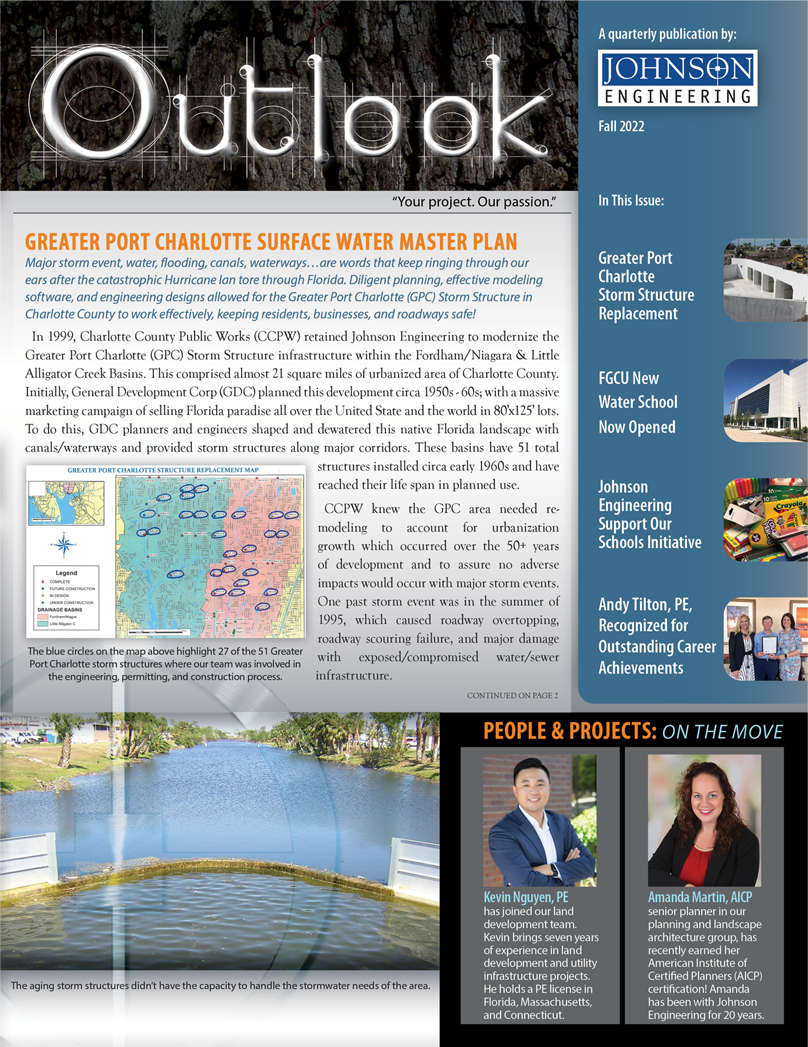Major storm event, water, flooding, canals, waterways…are words that keep ringing through our ears after the catastrophic Hurricane Ian tore through Florida. Diligent planning, effective modeling software, and engineering designs allowed for the Greater Port Charlotte (GPC) Storm Structure in Charlotte County to work effectively, keeping residents, businesses, and roadways safe!
In 1999, Charlotte County Public Works (CCPW) retained Johnson Engineering to modernize the Greater Port Charlotte (GPC) Storm Structure infrastructure within the Fordham/Niagara & Little Alligator Creek Basins. This comprised almost 21 square miles of urbanized area of Charlotte County. Initially, General Development Corp (GDC) planned this development circa 1950s – 60s; with a massive marketing campaign of selling Florida paradise all over the United State and the world in 80’x125’ lots. To do this, GDC planners and engineers shaped and dewatered this native Florida landscape with canals/waterways and provided storm structures along major corridors. These basins have 51 total structures installed circa early 1960s and have reached their life span in planned use.
CCPW knew the GPC area needed re-modeling to account for urbanization growth which occurred over the 50+ years of development and to assure no adverse impacts would occur with major storm events. One past storm event was in the summer of 1995, which caused roadway overtopping, roadway scouring failure, and major damage with exposed/compromised water/sewer infrastructure.
CCPW retained Johnson Engineering to survey, design, permit, and re-create the modeling of the GPC basins. The modeling required initially was Storm Water Management Model (SWMM), which is software from the United States Environmental Protection Agency (EPA) and allows a dynamic model and included inflows from Sarasota County. To acquire permits from Southwest Florida Water Management District (SWFWMD), the model was converted to Interconnected Channel and Pond Routing (ICPR) modeling software. This led Johnson Engineering to acquire a conceptual Environmental Resource Permit (ERP) from SWFWMD for the County. This conceptual ERP would be the guiding document to the systematic replacement of the 51 storm structures over the next 20+ years as funding/budgeting became available. The phasing and sequencing was interrupted with the 2004-05 hurricane seasons, with 2004 Hurricane Charley causing years of delay in order to address the repairs needed post-hurricane.
Most recently, as Hurricane Ian slowly and stubbornly made its destructive way through the area with relentless rain, wind and storm surge, the GPC renovated storm structure system performed without fail!
This table summarizes the project and our team’s involvement in the engineering, permitting, and construction of the storm structures in the project.
In addition, this work has been beneficial to the public in the following ways:
- Maximizing public right-of-way – The original storm structures installed by GDC spanned the roadway width only, which wouldn’t allow for many other amenities found in modern roadway/bridge construction, i.e. pathways, lighting, utilities. The new structures were designed and located to maximize the full right-of-way to allow for these amenities to be placed now or in the future.
- Along with these replacements, Johnson Engineering was instrumental in qualifying many of these structures as Florida Department of Transportation (FDOT) bridges due to the span in the waterways being >20 ft wide. Therefore, these structures will be on the FDOT bridge inventory to be inspected within the FDOT library on an annual basis.
- Needed utility upgrades at each structure were accommodated during design and construction. The initial 1960s construction of these storm structures was transportation focused with little accommodation for utilities (public and private) which eventually followed. As part of the new construction, utilities were addressed and accounted for.
- Since these 21 square miles of basin are mostly built out, this means the public transportation system at these structures is heavily used by commuters, residents, school busing systems, garbage collection, emergency management, and others as part of daily life. Johnson Engineering worked with these stakeholders to implement fast-track construction, detour routes, and on several structures required open roadways/sidewalk during construction to avoid major daily life interruptions.
The GPC basins have all been modernized with new storm structures with design life to last generations and CCPW has fulfilled their duty to protect the health, safety, and welfare of the citizens of Charlotte County. Johnson Engineering is proud to have worked in such a major role for this project.
For more information, contact Charlotte County Branch Manager, Chris Beers, PE, PSM at [email protected] or (941) 766-6262.

































































